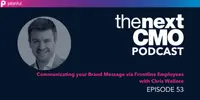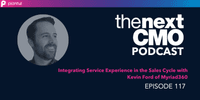In this episode, we speak to Chris Wallace, the co-founder and president of Innerview, a brand consulting firm with a unique perspective — they specialize in helping brands leverage their front line workers to communicate their brand values more effectively.
Episode Summary
In this episode, we speak to Chris Wallace, the co-founder and president of Innerview, a brand consulting firm with a unique perspective — they specialize in helping brands leverage their front line workers to communicate their brand values more effectively.
Innerview created a concept called the brand transfer score that helps measure how effectively your team communicates your brand message to your customers.
Chris has an amazing pedigree with a degree in communications from Syracuse and an MBA from Temple university, where he continues to teach as an adjunct faculty member.
If you are planning to invest in your brand, you definitely need to listen to this episode to make sure you are getting the most out of that investment.
Useful Links
Full Transcript
Kelsey Krapf: Chris. Thank you so much for joining the next CMO podcast today. We’re super happy to have you on the show. Love to learn a little bit more about you and what you do for interview.Chris Wallace: Well, Kelsey, thanks so much for having me on and Peter as well. I’m excited about the show. Um, a little bit about me. I’m trying to think, uh, trying to think where to start.Peter Mahoney: great. I L I liked the, uh, the idea that you are reformed. I actually refer to myself as a recovering CMO, uh, because, you know, since I dropped the mantle of CMO, when I started to run this company and found it, I, uh, I decided that recovering is probably the best way to talk about it.Chris Wallace: it’s a great way to think about it, for sure.Peter Mahoney: It is great. And obviously, I, I. Tongue was firmly planted in cheek. Chris, when you were talking about the love, hate relationship or hate, hate relationship between sales and marketing, because I, I think it’s really pretty dramatically improved over the years where I think marketing and sales people these days have a much better understanding of the relative value.Chris Wallace: communicate for sure. One thing I would, I would say, though, in our experience, we’ve seen the improvement in that relationship on the B to B to C side, excuse me, on the B2B side and significantly in the. You know, five, five to seven years, but we do a lot of work on the B to C side and the B to B to C side.Peter Mahoney: It makes a lot of sense. And it’s interesting because there there’s a lot that we see because we talked to a lot of marketing leaders from both B2B and B to C, and there’s a lot of really interesting sort of interplay between those two target markets that we see.Chris Wallace: you’re saying.Kelsey Krapf: So can you tell us a little bit more about your relationship between brand and customer experience?Chris Wallace: Yeah. I mean, I think this is another thing that’s really interesting. Um, on the, on the B to C side, um, customer experience has been, you know, a very fast growing trend and an area of focus for the last several years.Peter Mahoney: Yeah, it’s interesting because the. Th the, the implementation of brand when you’re dealing with people gets a little complicated, obviously.Chris Wallace: Yeah. So, so it’s an excellent question. The one thing I would say.Peter Mahoney: fascinating because I assume there’s a, the idea of sincerity or authenticity that comes through in those interactions when someone really believes in lives, the brand values is, is that the way we shouldChris Wallace: think about it? Yeah. I mean, I think that I jokingly Sam or reformed Salesforce. Uh, here, here’s a, here’s a little, a little tidbit.Peter Mahoney: you have a good. Example, maybe a juxtaposition of what happens when you do this right.Chris Wallace: Yeah. And I’m going to give you an, I’ll give you a couple of illustrations.Peter Mahoney: So is there like walking over hot coals kind of things that happen?Chris Wallace: Uh, I’ll give you an example of another, um, another engagement that we’ve done, major manufacturing brand consumer company. And they, um, we worked with our sales team.Peter Mahoney: It makes a ton of sense.Chris Wallace: You definitely, you literally just answered the question.Peter Mahoney: It’s interesting. Go ahead, Kelsey. Sorry, I’m gonnaKelsey Krapf: say, I’m curious how else you’re measuring the results of, you know, these brand transfers and merging the two together. Like how are you defining what those certain metrics are and how to achieve them toChris Wallace: every organization’s a little bit different Kelsey, but I can say that the ones that are most consistent are going to be sales conversion.Peter Mahoney: So it’s really fascinating, Chris, because if I, if I look at the brand projects that I’ve done over the years, as an example, we spent a lot of money on brand realization.Chris Wallace: out of that. No question. We jokingly call it marketing. So when you, when you have a major initiative that you’re undergoing, and when you say major organizational change, it’s typically things like, um, a merger, right? Or a merger acquisition, you know, a company rebrand, you know, that you product introductions, things like that.Peter Mahoney: How should we think about the implications of. Uh, channel organization. So if someone is interacting with their clients primarily through non-employees, is there a way to get them to embrace the brand and as a different in thatChris Wallace: case? Yeah. Th that’s that’s where we’re spending. Most of our time right now here is really around sort of the non-employee selling channels.Kelsey Krapf: So once you, you know, create these systems in place that are going to help with, you know, sales, the frontline and marketing, speaking together, and, you know, creating the same messaging, how do you make sure that your clients, uh, maintain that?Chris Wallace: Yeah. Um, well, once again, I’ll say that when we, when we do one of our, our branch transfer studies, um, there are, remeasures included with that.Peter Mahoney: So I L I love the concept that you guys created around this brand transfer score. Uh, so it sounds like what you’ve tried to do is correct. Sort of a standard diagnostic that helps people understand sort of, where are you on the, on the spectrum of being able to effectively communicate that brand value to the customer?Chris Wallace: system, Well, I’m pleased to nuts. We actually just released for the first time, our first ever aggregate brand transfer score.Peter Mahoney: Very interesting. It’s funny. I, my mind immediately went to the formula for the coefficient of restitution, uh, which is what measures the bounciness of balls is the way to think about it.Chris Wallace: that you’ve worked through? That’s a big area of focus for us right now, you know, we’re, we’re in the process of really trying to see if there’s causation between the, the, the brand transfer score and the, really the improvement in the brand transfer score.Peter Mahoney: Makes a lot of sense. I completely agree with that. And the, the idea of, of being able to validate some of those key assumptions is, is super important. Obviously, Chris and we talked a lot about the sales facing staff members, but obviously this kind of a brand transfer value applies also to anyone who’s customer facing.Chris Wallace: Really any odd. So, um, again, we do it with, with sales teams, we do it with customer service teams, or we do it with customer success teams. We do it with dealers, right? So, um, those are our favorite ones to do. We just did our first one with pharma. So when we broke into the pharma category, And we did it with healthcare providers, but not looking at the healthcare provider as a sell to audience, but a sell through audience.Peter Mahoney: Yep. That’s it. That’s amazing. And I completely agree that the, uh, you know, that kind of the sales transfer experience, I’m sure there’s a very strong, uh, there’s a very strong business case for, for that level of investment.Chris Wallace: Yeah. So my point of reference is going to be more on the B2C side. Okay. So my point of reference is about 10 to 15%. So, you know, we know, for example, we were talking to a client one time, but a major initiative that they were doing. And major product, they were pushing out and they told, we were told what the initial, just the ad spend was not how much they were paying their agency.Peter Mahoney: And when are the logical points for people to consider doing this kind of an assessment? Is it when you’re launching a big campaign, a big brick, new brand thing? Is it, is it any time? So how, how, how should the CMOs and the audience think about now that hopefully we’ve piqued their interest? What, what’s the right trigger point for them to, to look at making this kind of a new.Chris Wallace: It’s an excellent question. It’s probably one of the most important parts of the timing of this is really key. Most of the people that we work with. They, they come to us when something has been out there and has not performed as well as they wanted it to. So it’s usually the first conversation is a break fix type of conversation.Peter Mahoney: easy way to tell whether it’s likely a. Brand message transfer problem versus just a crappy message or a bad offer. So sometimes that happens too. And w w what are the things that a CMO should look out for to say that, that, Hey, this could be, this could be my frontline experience.Chris Wallace: Yeah. So, um, we get asked that question a lot. And I’m going to, I’m going to be disciplined and stay in my lane. They’re going to say, it’s not my job to tell you whether or not it’s a good message. That’s what your, your brand agency does for you, right? We’re a niche provider, but we’re a high value niche provider.Peter Mahoney: And what is the, what’s the scale that starts to make sense about putting the effort together to do this kind of program? Is it, is it, uh, 20 frontline people or 20,000? Uh, I suspect it’s somewhere in the middle.Chris Wallace: Yeah, it definitely is. So, um, we typically say with a brand transfer study, 50 people or more, if you’ve got 50 people out there representing you, and that can be through a variety of things.Peter Mahoney: Makes sense. So I know we’re getting to the end of our time, but this, this is really fascinating, Chris. Uh, and, uh, in it’s I look back again to the projects that I’ve been involved in over the years and the companies I’ve been involved in. And I, I can just, I know that.Chris Wallace: short.Kelsey Krapf: This has been great. Chris, I love the conversation and my wheels are definitely turning on some of the campaigns we’ve run and seeing whether or not it’s a brand transfer problem ourselves. So appreciate the, uh, the feedback and the insight. But lastly, we always love to ask, what advice would you give to aspiring CMOs or CMOsChris Wallace: today?Kelsey Krapf: Well, great. Thank you so much for your time today, Chris, make sure to follow the next GMO and plan out on Twitter. I’m sorry, the next day. Well, I’m Plannuh can I redoPeter Mahoney: that? Yes, we’ll do that.Kelsey Krapf: Thanks so much for your time today, Chris, make sure to follow the next demo and plan out on Twitter and LinkedIn.


